Household sous-vides, in our opinion, have ceased to cause bewilderment and unnecessary questions. At a minimum, among our acquaintances who are fond of cooking, the vast majority have clarified for themselves all the nuances regarding the purpose and rules of operation of this device. And many of those who have not yet decided to purchase this certainly useful gadget are using an ordinary multicooker with a temperature control function as a “budget sous-vide” with might and main. Of course, such a replacement cannot be compared with submersible or stationary sous-view in terms of convenience and accuracy of temperature control, however, this state of affairs suggests that cooking at low temperatures is in demand not only among lovers of haute cuisine, but also at the most ordinary household level. .
The hero of today’s test, the Anova AN-400 (aka Anova Nano) submersible sous vide, looks pretty standard in terms of appearance. However, the device is equipped with a wireless module that allows you to control it remotely using a mobile application. Theoretically, this can open up new opportunities for the chef or simply make his work easier, allowing you to control what is happening in the kitchen remotely. Let’s take a look at the device and see if this is really the case.

The AN-400 is the first Anova sous vide to hit our test lab. Frankly, we have long wanted to get acquainted with the products of this American company based in San Francisco. It should be noted that the company was founded in 2013, in 2014 it released its first sous vide, successfully collecting the requested $100,000 on the Kickstarter platform and significantly exceeding the initial desired amount (in total, the company was supported by more than 10,000 people, and the total amount of fees was $1.8 million). In 2017, the company was acquired by Swedish giant Electrolux for $250 million.
Characteristics
| Manufacturer | Anova |
|---|---|
| Model | Nano (AN-400) |
| Type | submersible sous vide |
| Country of Origin | China |
| Warranty | 1 year |
| Declared power | 750 W |
| Housing material | plastic, stainless steel |
| Control | electronic, remote (Bluetooth) |
| Control type | touch buttons |
| Display | LED |
| Temperature control | 0 to 92 °C in steps of 0.1 °C |
| Time control | up to 100 hours |
| Working volume | not specified |
| water circulation | 8 liters per minute |
| Instrument dimensions | 33×11×6 cm |
| The weight | 0.7 kg |
| Network cable length | 1m |
| average price | 15 thousand rubles at the time of publication of the review |
Equipment
Sous-vide came to us in an eco-package (in other words, in a box of technical brown cardboard) that contained almost no useful information (except, perhaps, the name of the model).
Inside the protective box, a second “ceremonial” package was found – a cardboard box designed using full-color printing.
After examining the box, you can find out general information about the device – the model name, weight and power of the device, dimensions, etc. There are also colorful photos of the device itself and ready meals, and a description of the main features.
The box looks “rich”: a device in such a package will be pleasant both to give and receive as a gift.

When we opened the box, we found that the device was protected from impacts with plastic pads and wrapped in a plastic film. Again – everything looks “expensive and rich.”

Inside the box we found:
- sous-vide itself;
- envelope with miniature instructions;
- fridge magnet.
At first sight
Visually, the sous vide gives the impression of being modern and stylish. Anova Nano is the youngest, most compact model in the Anova line, so the first thing that attracts attention is the small weight of the device. Our sous vide weighs only 700 grams.

The case is made of black matte plastic. The controls when turned off are not easily detected: the sous-vide has no mechanical buttons, and the screen when turned off is a regular black panel. The touch buttons are not visible at all.
Min and Max marks can be seen on the case, allowing you to determine the minimum and maximum allowable immersion level of the device. On the front of the case there is a slot with an LED indicator that changes color depending on the selected operating mode. At the back there is a power cord connector and a screw mount, with which the device is fixed on the wall of a container with water (for example, a saucepan).

The attachment point at the clamp is equipped with rubber pads, so that the device will not vibrate during operation, and the attachment will not scratch the pan.

At the bottom of the sous vide is a plastic protective cover that can be removed and installed back by turning a few degrees. The cover is installed and removed without effort.

Through the slots in the body that circulate water, you can see the standard sous-vide insides – a “boiler” that heats water, a paddle propeller that circulates water, as well as sensors that control temperature.
Note that the lower part of the body of the Anova Nano is non-removable. This means that if during operation you experience a depressurization of the bag, and its contents get inside the device, then you may encounter difficulties in cleaning. A sticker on the case warns that if you try to disassemble the device, you will lose warranty service.
Our experts once encountered such a problem while exploring another submersible sous vide. It was decided to immerse the device at the Max mark in water, to which a tablespoon of dishwashing detergent was added, and make it work for 1 hour at a temperature of 45 ° C. Then the sous-vide was taken out, the water was replaced with clean water and the procedure was repeated. According to all indirect signs, it was possible to wash the sous-vide: it did not smell at all, did not pollute the water during further work.
In general, the sous-vide seemed to us more than a pretty and very well-assembled device.
Instruction
The instruction manual for the device is a compact color brochure printed on glossy paper. The share of the Russian language accounts for only six pages, having studied which we will get acquainted with the main elements of the device, and also learn that to get started it is enough to place the products in a vacuum bag, and the bag in a pot of water.

We are offered to search for further instructions in the mobile application. Thus, we come to the obvious conclusion that the instruction in our case is present in the box simply because it should be there.
However, even in this case, the developer approached the issue in detail and without saving: it is pleasant to hold the book in your hands, it is well-designed and packed in a cute cardboard envelope.
In addition to the instructions, the envelope contained a fridge magnet containing tips on the most suitable temperatures for cooking the most common foods. For an experienced cook, it is hardly of any value, but a novice sous-vide user will probably look into it until he learns the main temperatures by heart.
Control
The device control unit consists of six illuminated touch buttons and an LED panel. The color of the buttons and the display of our sous vide is white, but the backlight can change (for example, to red if you try to turn on the device without water).
Pressing the buttons is accompanied by a short beep (click). The buttons work instantly. The values on the display are also updated without delay, which adds to the convenience of using the device.

The purpose of the buttons/icons on the control panel is as follows:
- thermometer – current temperature of the device;
- target (target) – setting the temperature to which the device should heat up (long press – switching between the Celsius and Fahrenheit scales);
- time – setting the cooking time;
- the on/off button, the “−” and “+” icons are understandable without explanation.
On the front of the housing there is an LED indicator that changes color depending on the status of the device.
Key events (completion of work, lack of water) are also accompanied by a sound signal.
In general, management seems to us very logical and understandable. All the rules adopted for submersible sous-vides are observed, and therefore, no problems should arise.
Note that you can select the desired mode before immersing the device in water. Checking for the presence of water is performed at the start of the program, which seems to us the most logical (we make this clarification for the reason that we came across devices that did not allow the user to select the mode if the device was not immersed in water).
There are no built-in programs for our device. Obviously, the device is designed for integration with a mobile application, and therefore all advanced options and features should be looked for there.
App control
The instrument can be controlled using the Anova mobile app, available for download from the Apple and Google stores.
Anova Nano, as a junior model, has limited functionality: you can only control the device via Bluetooth connection, while older models also allow Wi-Fi remote control. In simple terms, you can control this device only when you are in close proximity to it, while older models can be started and stopped remotely, and not just from home.
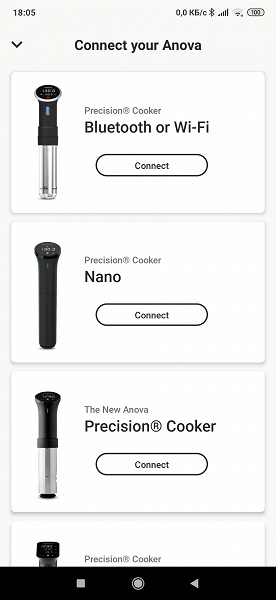
On first launch, the app will prompt you to connect to sous vide. The test information will be the temperature displayed on the screen: “We found a device that shows so many degrees. Connect to it or look for another? ”, – a solution that is brilliant in its simplicity and obviousness, which does not require any passwords, models and other nonsense from the user.
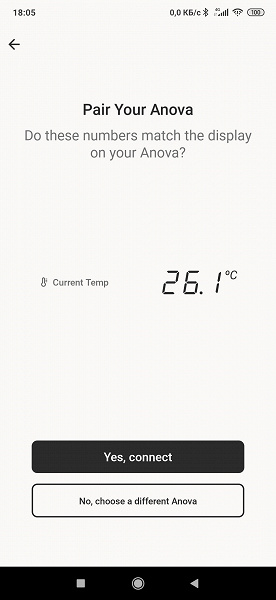
The simplest thing that the application allows you to do is to start the device remotely with the specified temperature and time settings.
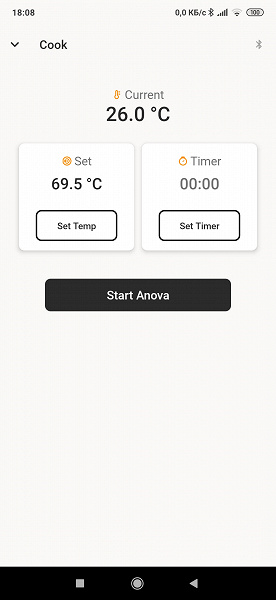
In addition, in the application you can find cooking guides for various types of products (accompanied by colorful photographs), as well as many recipes (with a description of the ingredients and, again, high-quality photographs of the cooking process).
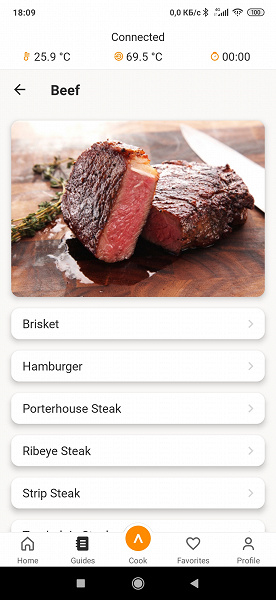
We rate the quality of the recipes as high: their compilers do not forget to inform us that we can choose different temperatures (for example, for different degrees of cooking meat), and also remind us of the need to increase the cooking time in case we are going to cook too thick a piece of the same meat.
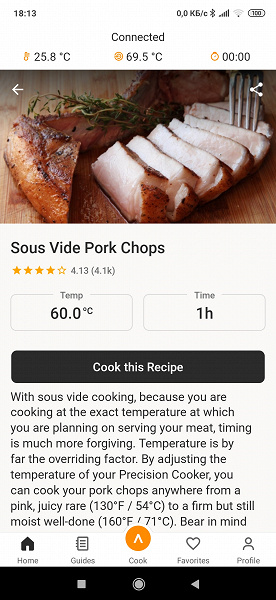
They will also remind us of when to season the meat with salt and spices (immediately – if you cook now or at the end of cooking – if you vacuum the meat for cooking later). And, of course, for each recipe there is a “cook this now” button.
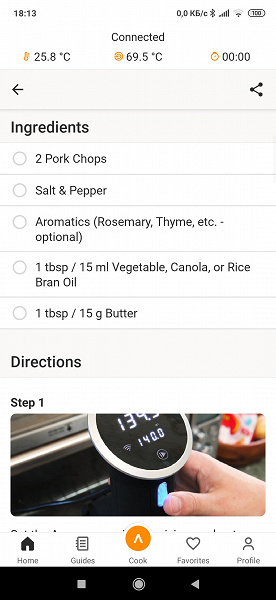
Favorite recipes can be saved to favorites to return to them later.
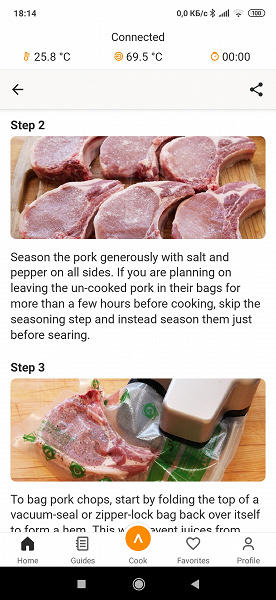
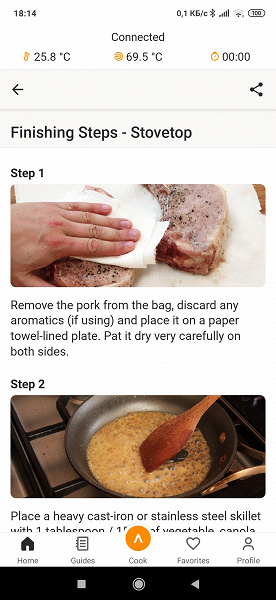
In general, the presence of such an assistant not only helps with the operation of the device, but can also serve as an inexhaustible source in case of difficulties such as “I don’t know what to cook for dinner tonight.”
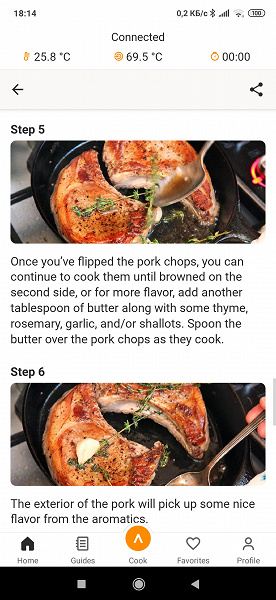
What does the younger model lack? In addition to the already mentioned Wi-Fi connection, our appliance cannot be started in the “stepped” cooking mode, such as when we put several products at once (for example, several steaks), which are cooked sequentially in different modes with an increase in temperature (which allows the cook to save time , removing the vacuum bags as they are ready).
Also, we cannot say anything comforting to those who do not know English: we do not know anything about plans to Russify the application.
Exploitation
Since sous vide does not imply direct contact with food, the device does not need pre-treatment before the first use. The user only needs to find a suitable container (usually a saucepan) of the required depth (according to the risk of a minimum water level on the body of the device), in which the vacuum bag can easily fit and where there is enough space for the free circulation of water.
During operation, we did not encounter any surprises related directly to the operation of the device. Our sous-vide turned out to be an absolutely adequate gadget that did exactly what it was supposed to do – heat the water to the specified temperature and maintain it for the specified time.
The timer (as expected) is activated when the set temperature is reached. Completion of the work is accompanied by a characteristic sound, which, however, is quite easy to miss. There is also no notification on the smartphone, so if you are in another room, then no one will remind you of anything – you will have to track the moment the cooking process is completed on your own.
However, there is nothing particularly terrible here: the device does not turn off after the timer expires, so our products will remain warm.
Sous vide also turns off and gives an audible warning if the water level drops to a dangerous level. In this case, add water to the pan and start the appliance again. Again, no warning is sent to the smartphone in this case. It’s a pity!
When operating, the sous vide produces noise caused by the operation of the propeller. We rate it as low: the buzzing is clearly audible in silence, but a low-volume TV will drown it out with ease.
The low power of the device is due to the fact that we have in front of us the youngest model in the Anova line, designed to cook 1-4 servings of food at a time. If 750 watts is not enough for you, then to speed up the cooking process, we would recommend pouring preheated water.
Let us mention once again that the lower part of the instrument case is non-removable, and therefore we would recommend that you carefully monitor the quality of the vacuum packaging. If the bag with liquid contents is depressurized during the cooking process, then washing the inside of the device (for example, from fat) will not be so easy.
Recall that to operate the device, you will have to acquire a household vacuum cleaner and a set of vacuum bags.
Care
Sous vide is easy to care for. The plastic housing should be wiped with a damp cloth, the blades and the heating element can be washed under running water with a little dishwashing detergent.
Our measurements
Energy consumption is a key parameter to consider when working with sous vide. Our device consumes about 1W in standby mode, about 10W in motor rotation mode and up to 690W in heating mode (which is slightly lower than the declared 750W).
To understand how much electricity is required to cook a particular dish, let’s give a couple of examples: warm water with a volume of 5 liters with an initial temperature of 30 ° C (poured from the tap) was brought to a temperature of 63 ° C in 20 minutes, for which 0.23 kWh was spent. Maintaining the same temperature for 45 minutes increased the total electricity consumption to 0.34 kWh.
A chicken breast that was cooked at 63.5°C for an hour and a half (in the same five liters of water) required 0.52 kWh and started cooking in 40 minutes at a starting temperature of 22°C (room temperature). water).
About 3.7 kWh was spent on pork at a temperature of 73 ° C in 16 hours.
In all cases, the preparation was carried out in a metal saucepan without a lid. This means that the heat loss was quite noticeable, and if you have a special sous-vide device (a container with a lid and / or thermal insulation), then the electricity consumption will certainly be lower.
In general, the main thing that the user needs to take out of this paragraph is: when calculating the cooking time, we lay down from 20 minutes to 1 hour to heat the water (the higher the temperature, the more time it takes). As the temperature rises, the time will increase non-linearly: heating water from 50 to 60 °C will occur much faster than heating from 70 to 80 °C. However, no one forbids pouring hot water from the kettle into the pan and starting cooking almost immediately.
Note that our temperature measurements using a control thermometer showed a slight deviation of the actual temperature from the set one: at the set 60 ° C, depending on the chosen measurement location (directly next to the device or on the opposite edge of the container), the deviation ranged from 0.1 to 0 .2 °C. In our opinion, such a discrepancy should be recognized as extremely insignificant and it makes no sense to pay attention to it.
practice tests
Chicken egg
Let’s start our test by cooking regular chicken eggs: 62.8°C and 45 minutes is enough time to get soft, creamy whites and runny yolks.
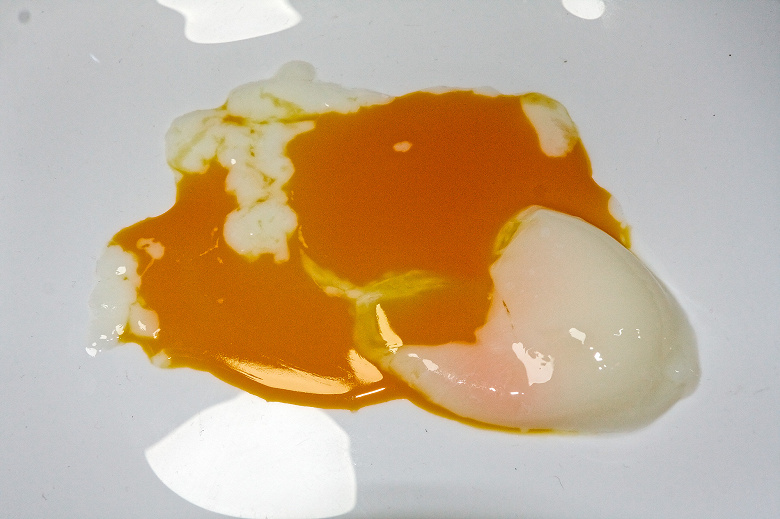
Such eggs can be mixed into a ready-made side dish (for example, rice) or used to make poached eggs (for this, the eggs will have to be carefully peeled and poured into barely boiling water). The process will be much easier than with raw eggs, because we don’t have to worry too much about the protein spreading in the water and losing its shape.
Result: excellent.
Chicken breast with smoked paprika and other spices
To cook the chicken fillet (chicken breast), we set the temperature to 63.5 °C and the time for an hour and a half.
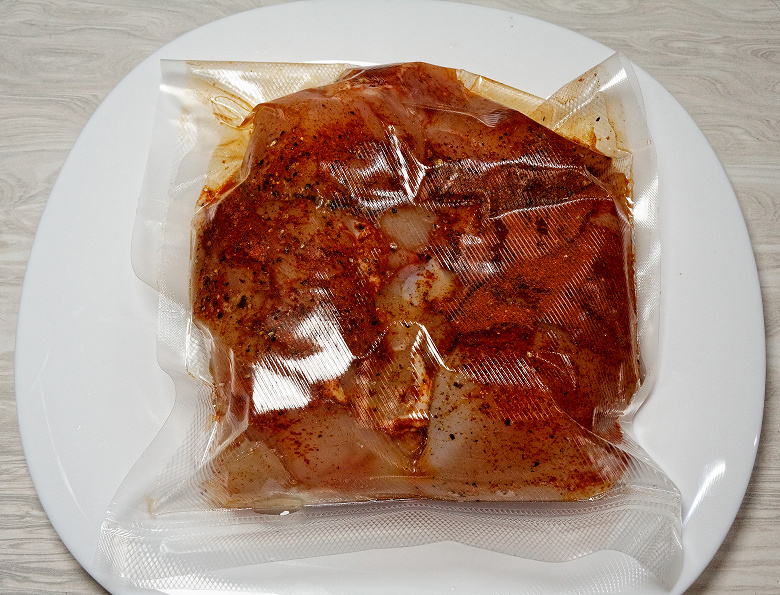
The breast was previously placed for 45 minutes in a marinade consisting of water with sugar and salt. Then they took it out, dried it and generously smeared it with spices – first of all, smoked paprika and ground pepper come here. You can also add garlic powder, dried lemon peel, cardamom, etc. Vacuumized with a piece of butter.
The cooking process did not give us any surprises. The chicken breast turned out to be exactly what we expected to see it: juicy, moderately dense, with a distinct taste. Such a breast is suitable for sandwiches, and for salads, and for subsequent frying (which we did – we took the finished breast and fried until a crust formed over high heat).
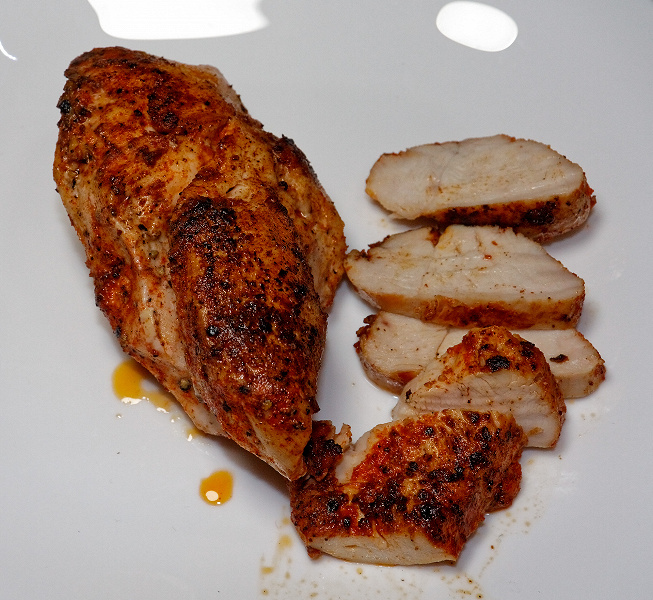
Result: excellent.
Glazed carrots with honey
The carrots were cut into small pieces, placed in a vacuum bag, butter, a few tablespoons of honey, a little salt and pepper were added there.
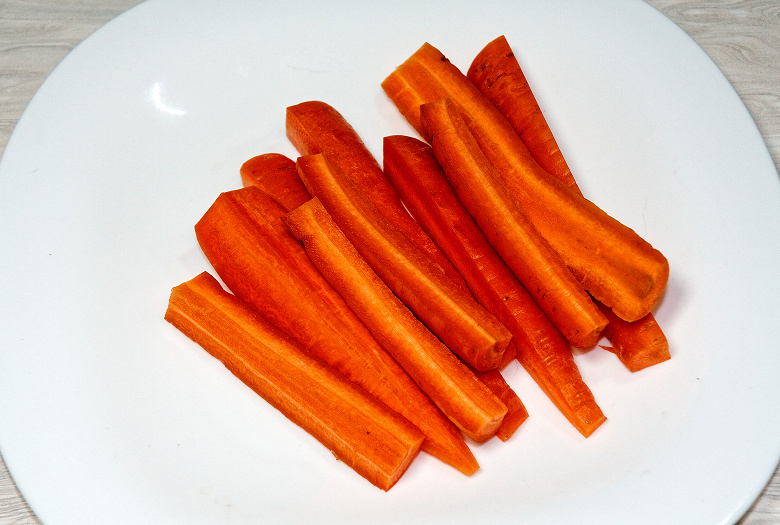
Cooked for an hour at 83.9°C.
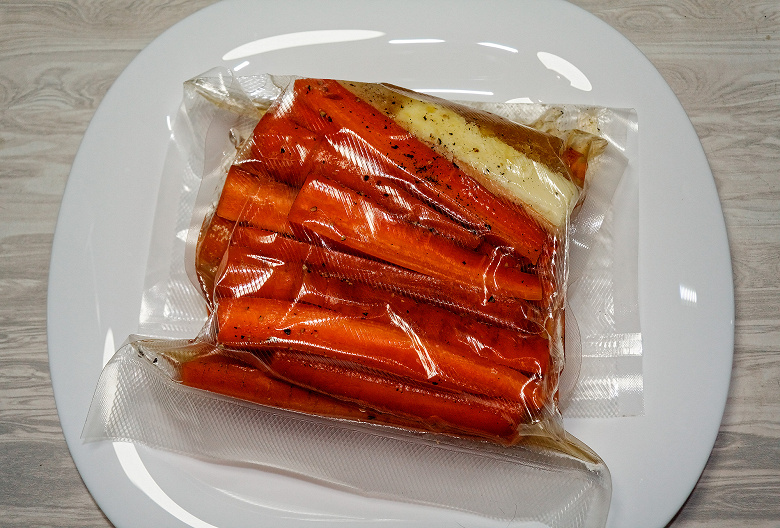
At the end of cooking, the package was opened and its contents were laid out (poured) into a hot pan, after which they were fried until the liquid turned into caramel.
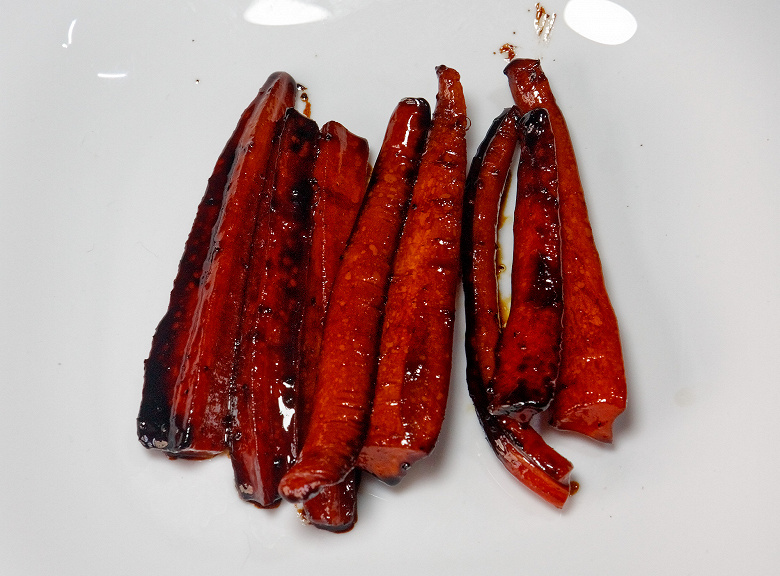
Such carrots are best served immediately, with fresh herbs, lightly sprinkled with coarse salt.
Result: excellent.
bean pods
Such beans are traditionally used in Chinese (Sichuan) cuisine, frying them in a wok, however, under the influence of high temperatures, the products are quite easy to overcook.
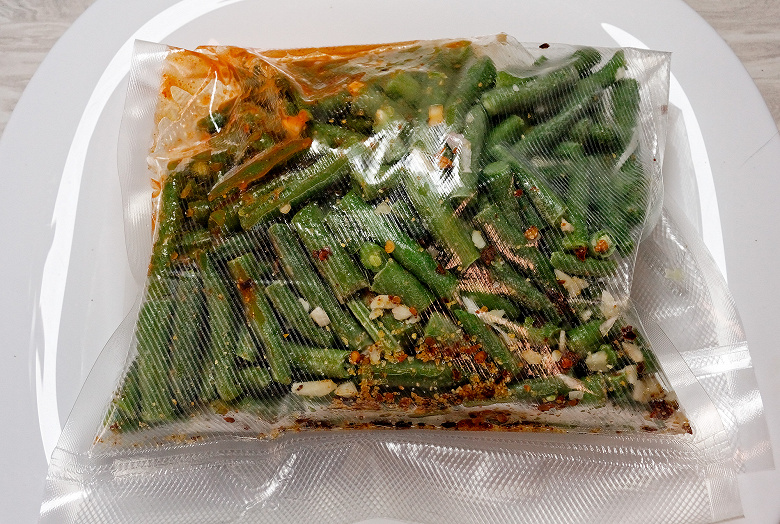
We vacuum-packed the beans, some chili sauce, hot pepper flakes, dried onion, sesame oil, and garlic salt. Shake well and pack the bag in the “wet products” mode.
Place the bag in a saucepan and cook for 45 minutes at 85.6°C.
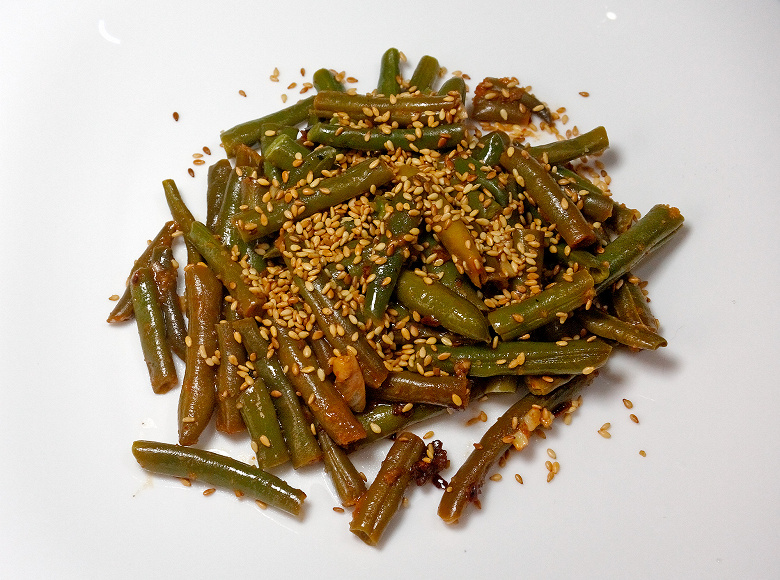
To serve such beans, you can use roasted sesame seeds and chopped green onions.
Result: excellent.
pork shoulder
For cooking pork shoulder, a temperature of 63 ° C (if we are going to cut it into pieces) or 74 ° C (if we need “pulled pork”) is suitable. We decided to go the second way.
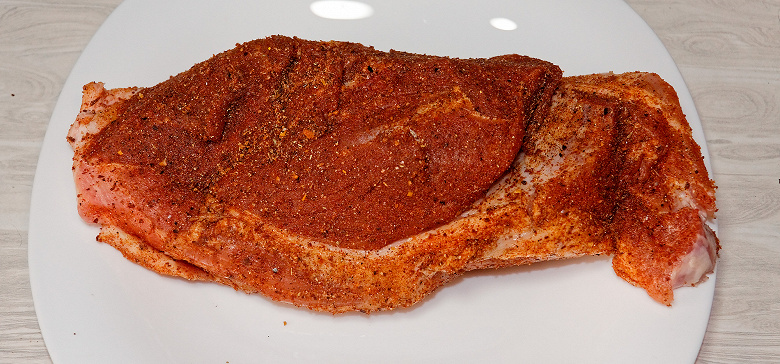
As spices, a combination of paprika, brown sugar, salt, mustard seeds, black pepper, garlic powder, oregano, coriander seeds and hot red pepper is suitable. All this must be carefully chopped and rubbed with a mixture of pork before packing in a bag.
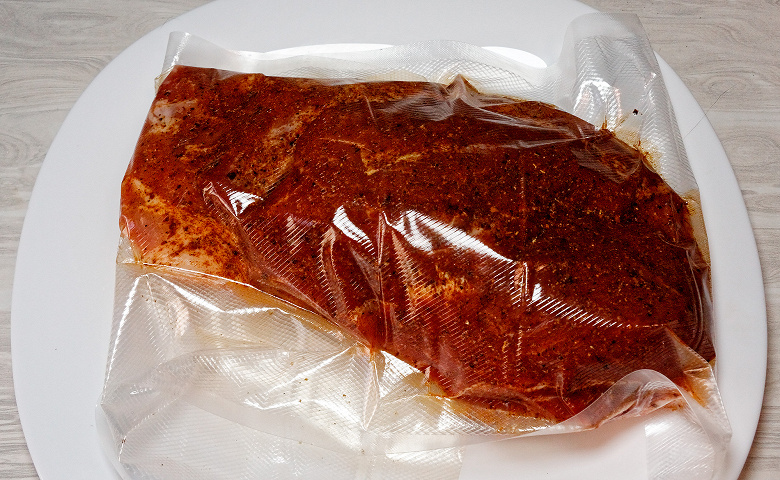
It is recommended to leave part of the mixture in order to re-grate the meat after removing it from the vacuum bag.
The recommended cooking time for a large piece (2-4 kg) is 18 to 24 hours.
At the end of the process, remove the meat from the package.
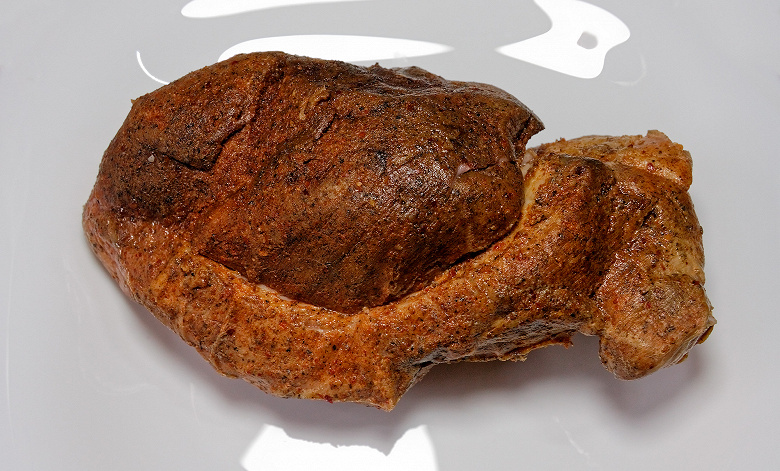
We dry it, lightly rub it with spices (again), send it to the oven, heated to 150 ° C, and wait until the outer layer darkens (for an hour and a half, depending on the size of the piece).
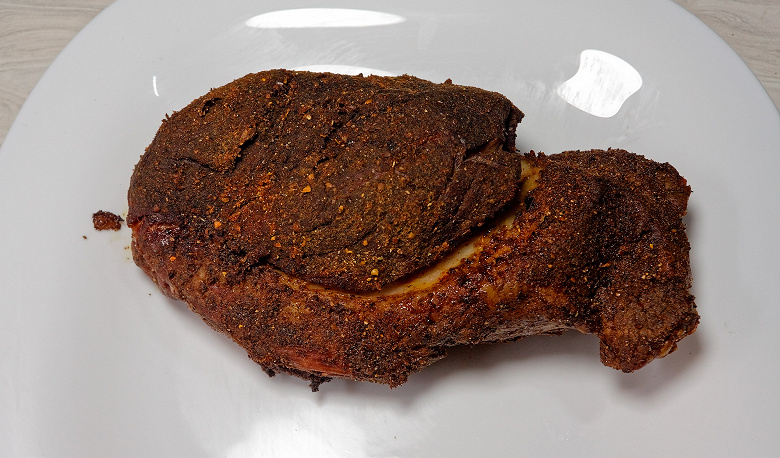
Ready pork is easily “disassembled” into fibers by hand. Or (if you don’t want to get burned) – with the help of two forks.
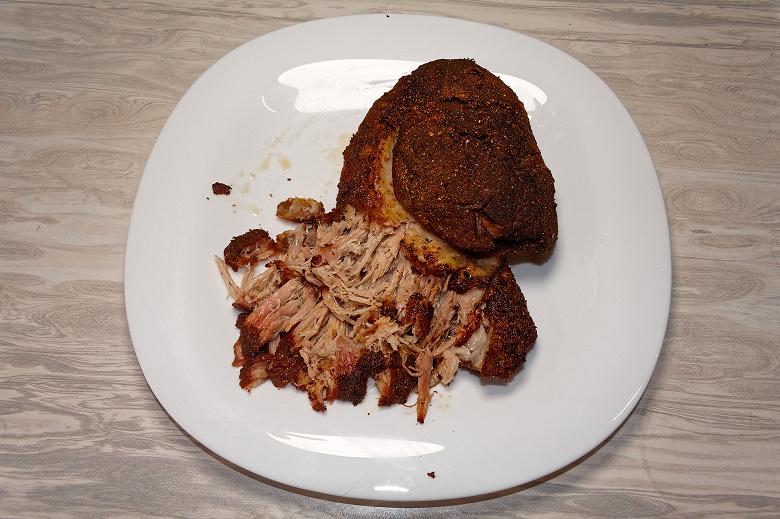
Ready pulled pork can be used to prepare all kinds of dishes or simply as a filling for sandwiches.
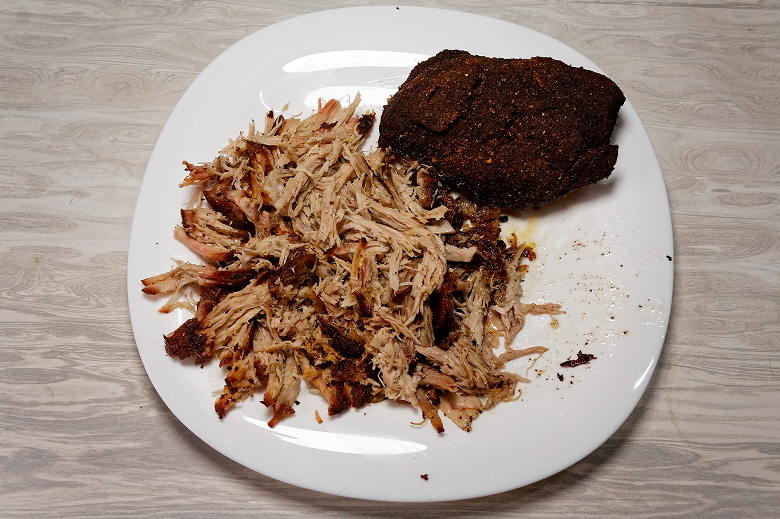
Result: excellent.
findings
Sous vide Anova Nano made an extremely positive impression on us. If you close your eyes to the not too well-implemented user notification system (it’s quite easy to miss the device’s sound signal, and notifications don’t come to your smartphone), then we have a modern, stylish and adequate device in terms of power that can easily cope with cooking all kinds of dishes for a family of several people.

Separately, we note the high quality of a special application in which you can find recipes and sources of culinary inspiration for all occasions. These same recipes can be added to your favorites and subsequently used as a shopping list, checking them directly in the store. Very convenient, especially for those who are just starting to get acquainted with cooking in sous vide.
By purchasing Annova Nano, we will not be able to control the device via Wi-Fi, as well as access to the Multistep function, which allows, in particular, to cook several pieces of meat with different degrees of “doneness” (despite the fact that the site su-vide.ru is mistaken declares the presence of such a function). All this is reserved for the company’s older models. However, we will not write it down as a disadvantage: it is quite logical that the younger (cheaper) models will be limited in functionality. Those who need these features can pay attention to the standard or even professional version of Anova (which, by the way, produces as much as 1800 watts of heating power).
pros
- stylish look
- Bluetooth control
- high-quality application with a large database of recipes
Minuses
- not very successful implementation of user notifications
Submersible sous vide Anova Nano (AN-400) provided for testing by su-vide.ru




